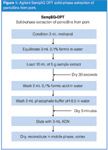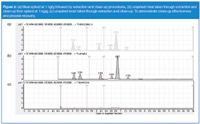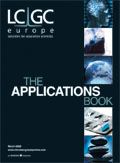Determination of Penicillins in Meat by High Performance Liquid Chromatography (HPLC-UV) and HPLC–MS–MS
Penicillins are regulated substances in food for human consumption. The minimum residue limits range from 1 ng/g to as high as 50 ng/g depending on the compound. Because of the complexity of food matrices measuring the level of contaminants requires a total solution composed of sample extraction, sample clean-up, chromatographic separation and detection. In this paper, a solid-phase extraction method with a high performance liquid chromatography tandem mass spectrometry method (HPLC–MS–MS) is shown for the simultaneous determination of six antibiotic residues.
Carol Ball, Agilent Technologies Inc., Wilmington, Delaware, USA.
Introduction
Penicillins are antibiotics widely used to treat diseases in animals and as a result, are occasionally found in animal products destined for human consumption. In this application, a solid-phase extraction method with a high performance liquid chromatography tandem mass spectrometer (HPLC–MS–MS) is shown for the simultaneous determination of six antibiotic residues: azlocillin, penicillin G, oxacillin, cloxacillin, nafcillin and dicloxacillin in animal tissues (porcine muscle).
In the method, a reversed-phase column Agilent ZORBAX Eclipse Plus C18 (3.5 μm, 100 mm × 2.1 mm) and an Agilent mixed mode polymer solid-phase extraction cartridge, Agilent SampliQ OPT were combined to give a total solution to the analysis of residual penicillins. The performance of the solid-phase extraction procedure on trace residues is quantitatively evaluated by HPLC–MS–MS.
Experimental
Sample Preparation
Extraction
Weigh 5 g of raw ground pork (accurate to 0.01 g) into a 50 mL capped polypropylene centrifuge tube, add 15 mL of acetonitrile/water (15:2). Homogenize completely using the Brinkman Polytron (1 minute). Centrifuge at 4000 rpm and 4 °C for 5 minutes. Save the supernatant. Add 10 mL acetonitrile/water (15:2) to pellet, mix with a spatula to resuspend the ground meat. Homogenize for 1 minute. Centrifuge at 4000 rpm and 4 °C for 5 minutes. Combine supernatants. Repeat one additional time.
Take the combined supernatants and place into a round bottom flask and evaporate the acetonitrile at 37 °C. There should be approximately 6 mL of water remaining in the flask.
Bring the total volume to 20 mL using pH 8.5 phosphate buffer. Filter with an Agilent regenerated cellulose, 25 mm, 45 μm syringe filter. Load 10 mL of extract onto the Agilent SampliQ OPT 6 mL/150 mg SPE cartridge.
Purification
The procedure for SPE extraction is shown in Figure 1. Load 10 mL of the extract onto the conditioned and equilibrated cartridge. The cartridge is washed with 0.1% formic acid in water and then pH 8.5 potassium phosphate buffer. Finally, the sample is eluted with 3 mL acetonitrile. The sample is filtered with a 13 mm, 45 μm Agilent PTFE syringe filter. The eluent is dried under nitrogen at room temperature. The residue is resuspended in mobile phase to 1.0 mL. The sample is vortexed for 2 minutes and then transferred to a 2 mL Agilent autosampler vial.

Figure 1
Results and Discussion
Figure 2 shows the chromatograms of the meat spike sample at the limit of quantification (LOQ), 1.0 ng/g (2a), the matrix spiked blank at the LOQ [2(b)] and the meat extract blank [2(c)]. The cleaned-up pork extract does not show any interferences with the target analytes. External standard calibration curves were made in spiked meat blank extracts over the range of 0.2 to 20 ng/g. The recoveries at the LOQ (n = 6) are: 77.8% for azlocillin, 43.6% for penicillin G, 96.5% for oxacillin, 86.3% for cloxacillin, 98.5% for nafcillin and 105.7% for dicloxacillin. At 20 ng/g the recoveries are 75.5% for azlocillin, 48.8% for penicillin G, 102.8% for oxacillin, 95.3% for cloxacillin, 101.9% for nafcillin and 103.9% for dicloxacillin. The HPLC method uses a ZORBAX Eclipse Plus C18 column which provides excellent peak shape and resolution of this sample. The Rapid Resolution 3.5 μm column was chosen to provide high resolution and the 2.1 mm i.d. was good for use with the MS detector.

Figure 2
Conclusion
The results of this study show that the Agilent SampliQ OPT cartridge provides an effective method for cleaning up complex food samples such as porcine muscle. This is demonstrated using penicillins as target compounds with a method using a ZORBAX Eclipse Plus C18 column. HPLC-UV is used as a detector to demonstrate the extent of clean-up, which is found to be excellent. The LC–MS–MS is used to demonstrate the recovery of the penicillins at trace level. Even with extensive extraction and SPE clean-up, recoveries are acceptable and reproducibilities are excellent.
References
1. Carol Ball, "Determination of Penicillins in Meat by High Performance Liquid Chromatography (HPLC/UV) and HPLC/MS/MS", Agilent Application Note 5990-3364EN.

Agilent Technologies, Inc.
2850 Centerville Road, Wilmington Delaware USA 19808
tel. +1 800 227 9770 fax +1 302 633 8901
E-mail: info_agilent@agilent.com
Website: www.agilent.com/chem

Removing Double-Stranded RNA Impurities Using Chromatography
April 8th 2025Researchers from Agency for Science, Technology and Research in Singapore recently published a review article exploring how chromatography can be used to remove double-stranded RNA impurities during mRNA therapeutics production.











